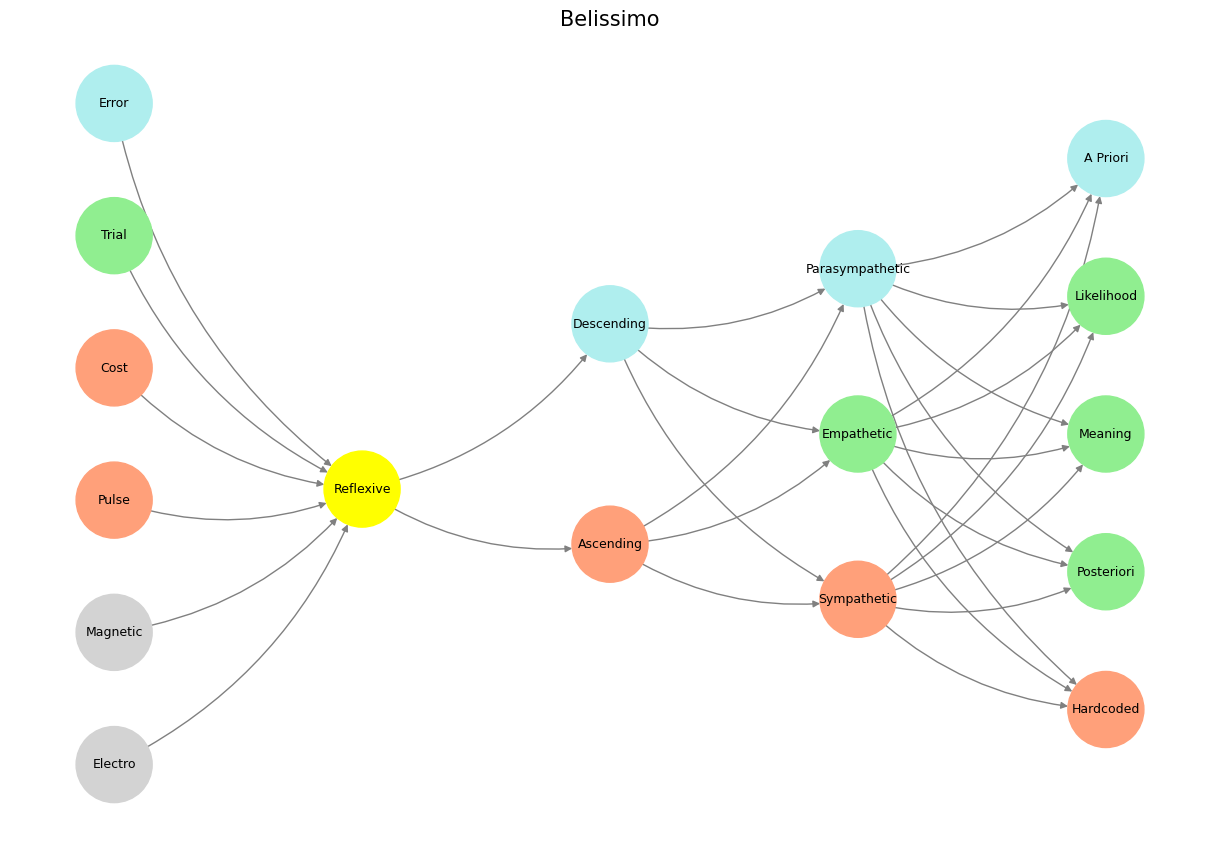Born to Etiquette#
The nature of power, movement, and adaptation can be understood through the interplay of three distinct yet interwoven figures: the Imperial Queen, the White Pawn named Alice, and the Red Queen. Each represents a mode of existence, a force governing the rhythms of action and response, and a state of being within a vast and intricate system. The Imperial Queen, ruling with a stillness that disguises absolute control, presides as the parasympathetic force—a monarch whose authority is exerted through patience, presence, and strategic non-action. Alice, the White Pawn, embodies the empathetic, the gentle yet inexorable pull toward transformation, the capacity to move forward with curiosity rather than conquest. The Red Queen, relentless and fierce, surges with the intensity of the sympathetic drive—survival through velocity, the necessity of constant movement to avoid stagnation, the cruel logic of evolution itself.
The Imperial Queen’s power is measured in her restraint. She sits at the center of the board, exuding an authority that requires no haste, no frantic grasping for control. Her dominion is vast not because she moves often, but because all movement ultimately orbits her. This is the parasympathetic state, the equilibrium that allows the body to recover, to absorb, to rule not through sheer force but through the inexorable pull of presence. Her power is the power of conservation, the quiet but total grip of inevitability. Just as the parasympathetic system slows the heart and deepens the breath, commanding the body into a state of repair, the Imperial Queen commands through economy. She does not chase. She is simply there, an axis around which all others must turn.

Fig. 30 I got my hands on every recording by Hendrix, Joni Mitchell, CSN, etc (foundations). Thou shalt inherit the kingdom (yellow node). And so why would Bankman-Fried’s FTX go about rescuing other artists failing to keep up with the Hendrixes? Why worry about the fate of the music industry if some unknown joe somewhere in their parents basement may encounter an unknown-unknown that blows them out? Indeed, why did he take on such responsibility? - Great question by interviewer. The tonal inflections and overuse of ecosystem (a node in our layer 1) as well as clichêd variant of one of our output layers nodes (unknown) tells us something: our neural network digests everything and is coherenet. It’s based on our neural anatomy!#
Alice, the White Pawn, is movement in its most innocent form, the act of stepping forward with an open heart rather than with a sword drawn. She is not yet a Queen, not yet anything except possibility. Empathy, her defining trait, is often dismissed as powerless, yet it is the force that allows her to navigate the absurdity of the world without succumbing to it. Her progress is slow, methodical, and one-directional, but she alone has the potential to reach the final rank and transform. In a world dictated by forces larger than herself, she moves with sincerity rather than calculation, feeling rather than dominance. The White Pawn’s advance is not driven by conquest but by an almost naïve commitment to exploring what lies ahead, making her a paradox: the most limited piece on the board, yet the only one that may become anything at all.
The Red Queen is movement itself, but movement without rest, survival through acceleration. In her domain, stasis is death, and only through relentless adaptation can anything endure. This is the law of the sympathetic system, the state of fight or flight, the surge of adrenaline, the evolutionary race where one must run just to stay in place. The Red Queen understands that power is an illusion unless it is constantly renewed, that there is no throne to sit upon because to stop running is to be consumed. Where the Imperial Queen embodies absolute rule, and Alice embodies the dream of transformation, the Red Queen embodies raw, unceasing competition. Her realm is one of ceaseless urgency, the biological imperative that ensures survival but never peace. She does not wait. She does not reflect. She does not grant reprieve.
The tension between these forces defines existence itself. Life oscillates between the Imperial Queen’s stillness, Alice’s curiosity, and the Red Queen’s desperate momentum. To live only in the realm of the parasympathetic is to rule in solitude, untouched but static. To live only as Alice is to wander without knowing the cost. To live only in the domain of the Red Queen is to burn without rest, to be trapped in an endless race that no one wins. Mastery is not choosing one over the others, but learning when to inhabit each. To know when to move forward with the quiet assurance of Alice, when to command with the authority of the Imperial Queen, and when to run as if survival itself depended on it.
Each force exerts its pull, and none can be denied. The Imperial Queen reminds us that power does not always require action. Alice reminds us that growth requires openness. The Red Queen reminds us that without adaptation, we perish. We move through these states, not as choices but as inevitabilities, cycling between rest, motion, and survival. The game does not end, nor does it offer easy victories. But to understand these forces is to move with them rather than against them, to recognize the nature of the board itself. In the end, all must learn to play their roles, for whether one rules, transforms, or runs, the game continues.
Show code cell source
import numpy as np
import matplotlib.pyplot as plt
import networkx as nx
# Define the neural network fractal
def define_layers():
return {
'World': ['Electro', 'Magnetic', 'Pulse', 'Cost', 'Trial', 'Error', ], # Veni; 95/5
'Mode': ['Reflexive'], # Vidi; 80/20
'Agent': ['Ascending', 'Descending'], # Vici; Veni; 51/49
'Space': ['Sympathetic', 'Empathetic', 'Parasympathetic'], # Vidi; 20/80
'Time': ['Hardcoded', 'Posteriori', 'Meaning', 'Likelihood', 'A Priori'] # Vici; 5/95
}
# Assign colors to nodes
def assign_colors():
color_map = {
'yellow': ['Reflexive'],
'paleturquoise': ['Error', 'Descending', 'Parasympathetic', 'A Priori'],
'lightgreen': ['Trial', 'Empathetic', 'Likelihood', 'Meaning', 'Posteriori'],
'lightsalmon': [
'Pulse', 'Cost', 'Ascending',
'Sympathetic', 'Hardcoded'
],
}
return {node: color for color, nodes in color_map.items() for node in nodes}
# Calculate positions for nodes
def calculate_positions(layer, x_offset):
y_positions = np.linspace(-len(layer) / 2, len(layer) / 2, len(layer))
return [(x_offset, y) for y in y_positions]
# Create and visualize the neural network graph
def visualize_nn():
layers = define_layers()
colors = assign_colors()
G = nx.DiGraph()
pos = {}
node_colors = []
# Add nodes and assign positions
for i, (layer_name, nodes) in enumerate(layers.items()):
positions = calculate_positions(nodes, x_offset=i * 2)
for node, position in zip(nodes, positions):
G.add_node(node, layer=layer_name)
pos[node] = position
node_colors.append(colors.get(node, 'lightgray'))
# Add edges (automated for consecutive layers)
layer_names = list(layers.keys())
for i in range(len(layer_names) - 1):
source_layer, target_layer = layer_names[i], layer_names[i + 1]
for source in layers[source_layer]:
for target in layers[target_layer]:
G.add_edge(source, target)
# Draw the graph
plt.figure(figsize=(12, 8))
nx.draw(
G, pos, with_labels=True, node_color=node_colors, edge_color='gray',
node_size=3000, font_size=9, connectionstyle="arc3,rad=0.2"
)
plt.title("Belissimo", fontsize=15)
plt.show()
# Run the visualization
visualize_nn()


Fig. 31 Glenn Gould and Leonard Bernstein famously disagreed over the tempo and interpretation of Brahms’ First Piano Concerto during a 1962 New York Philharmonic concert, where Bernstein, conducting, publicly distanced himself from Gould’s significantly slower-paced interpretation before the performance began, expressing his disagreement with the unconventional approach while still allowing Gould to perform it as planned; this event is considered one of the most controversial moments in classical music history.#

